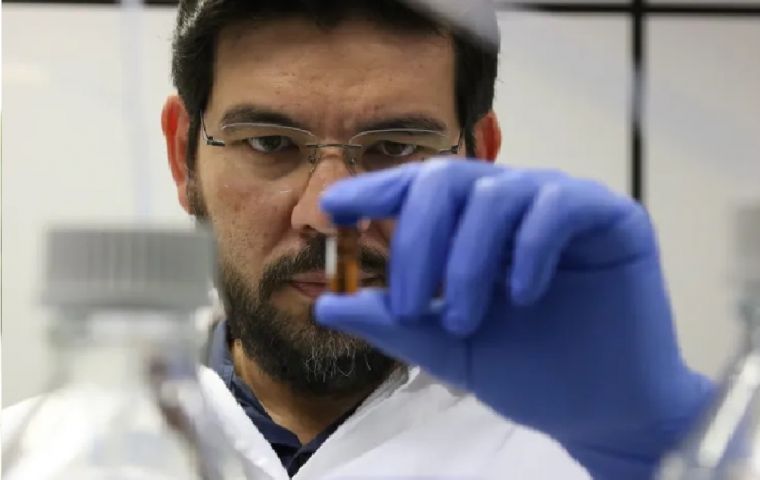MercoPress. South Atlantic News Agency
Brazilian scientists find enzyme that can transform waste into biofuel
 “This discovery changes the paradigm of cellulose degradation in nature,” Murakami explained
“This discovery changes the paradigm of cellulose degradation in nature,” Murakami explained Scientists at Brazil's National Center for Research in Energy and Materials (CNPEM) have discovered a biocatalyst called CelOCE (Cellulose Oxidative Cleaving Enzyme) stemming from a soil bacteria, which can transform waste into biofuel. The enzyme, isolated from bacteria found in sugarcane bagasse, enhances the breakdown of cellulose, increasing glucose release by up to 21%. The study showing these findings was published Thursday in the journal Nature.
CelOCE is composed of only 115 amino acids, making it easier to modify and potentially revolutionizing biorefineries and the biomass-based production chain. The enzyme has been patented and may be used industrially within one to four years.
This discovery is part of a broader effort to map the microbial life of Brazilian biodiversity and could have applications in recycling in the petrochemical and plastics industries.
The research ranged from bioprospecting, in which microorganisms with potential were identified, to the production of the enzyme on an industrial scale in CNPEM's pilot plant.
This discovery was not an accident - it was part of the results of the genetic mapping program of the microbial life of Brazilian biodiversity, carried out by CNPEM together with national and international partners. A similar effort allowed the isolation of compounds with potential medical use from bacteria in a conservation unit in the Amazon. This research was carried out in cooperation with the French National Research Institute for Agriculture, Food and Environment (INRAE, Aix-Marseille University) and the Technical University of Denmark (DTU).
The method used to identify CelOCE could also be applied in other conditions and reveal compounds with potential for recycling in the petrochemical and plastics industry. In a sense, it is a matter of “spying” on bacteria and replicating their solutions.
CelOCE's “flexibility” is one of the reasons why the CNPEM team sees it as a breakthrough with the potential to transform the biomass-based production chain. Its use could be extended to the production of fuels and petrochemical by-products, such as plastics, organic acids, and other molecules. Tests under industrial conditions showed that, when combined with enzymes already used in industry, CelOCE increases the amount of glucose released from plant residues by up to 21%.
This enzyme acts by accelerating the breakdown of cellulose through a deconstruction process, a key step in the production of biochemicals and energy. “This discovery changes the paradigm of cellulose degradation in nature and has the potential to revolutionize biorefineries,” explained Mario Murakami, CNPEM researcher and leader of the study.
“The research focused on elucidating metagenomic dark matter, i.e. genes of unknown function in unpublished, non-laboratory-culturable microorganisms. More than 90% of microbial life remains unknown and could contain information that transforms our understanding of many natural processes, such as cellulose degradation, which was precisely the finding of this study,” he concluded.
(Source: Agencia Brasil)




Top Comments
Disclaimer & comment rulesCommenting for this story is now closed.
If you have a Facebook account, become a fan and comment on our Facebook Page!